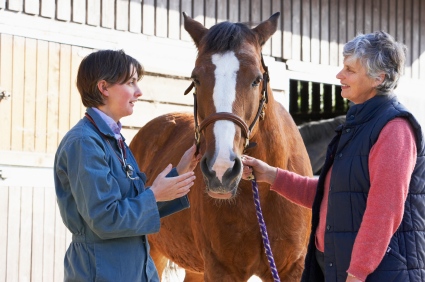 The best thing you can do for the health of your horse is to have a good working relationship with their veterinarian that includes good, honest communication. Whether it be scheduling appointments, discussing a treatment plan, emergency visits, or routine updates, good communication is imperative to maintaining a healthy relationship with your veterinarian and veterinary care team. But what happens if that communication breaks down?
The best thing you can do for the health of your horse is to have a good working relationship with their veterinarian that includes good, honest communication. Whether it be scheduling appointments, discussing a treatment plan, emergency visits, or routine updates, good communication is imperative to maintaining a healthy relationship with your veterinarian and veterinary care team. But what happens if that communication breaks down?
Being cognizant of your veterinarian’s normal business hours and explaining what you as a client desire in your communication expectations are just a few ways you can help improve this relationship. Veterinarians know how important timely communication is to owners, but determining what each owner wants in frequency and detail is often the point where breakdowns occur.
Have an Established Veterinarian for Routine Care
An important first step in this relationship is to ensure that you have a veterinarian established for routine care of your horse so that when emergencies arise, you have someone to call. Many mobile vets will only see existing clients for emergencies, as they are acquainted with their clients and their horses and can depend on them for compliance and payment. Much like human medicine, most veterinarians cannot accommodate emergencies at a moment’s notice, especially when they have existing clients that need their attention. A good veterinarian-client-patient relationship goes a long way in ensuring the best care for your horse for both routine and emergent situations.
Can it wait?
Just like you, your veterinarian has a personal life and family as well as their work. Veterinarians typically have procedures in place for their staff and assistants to handle scheduling and routine inquires. Knowing who to contact in the practice via email, text, or phone call can help get you the information you need in a timely fashion.
Remember to respect “normal operating hours”. If your veterinarian has given you their cell phone number, or a direct line to reach them, they have likely done so with the expectation it will be treated as one would their personal primary care physician. This means that non-emergent, routine questions and appointment requests will be made during normal business hours.
It’s best to ask your vet how they would like you to contact them for emergencies. For instance, is there a specific emergency line you should call or do you call their regular office number after hours?
Being clear about communication preferences upfront prevents any discrepancies in the future from damaging the relationship you have with your veterinarian.
What are Your Expectations as a Client?
As a client, you should be clear about and reasonable in the expectations you have for communication from your veterinarian. Establish what information you want from your veterinarian with the understanding that you are only one of their many clients. The way your previous veterinarian communicated with you may not be the same way your new veterinarian prefers to do so. If you feel the line of communication is lacking, let your vet know so the two of you can work together to see if something can be implemented or changed in the future.
Additionally, decide how often and through what avenue you would like to be contacted. For example, if you have a horse hospitalized, do you want updates daily or is every other day acceptable? Do you wish to be contacted by a text message, phone call, or email? Be clear with what you prefer, and your veterinarian can try to meet your expectations to the best of their ability.
Conclusion
Breakdowns in communication can happen to anyone and can sour a good veterinarian-client relationship quickly. Ultimately, if you feel unhappy with your vet’s communication methods, be open to discussing alternatives. Additionally, if your vet is unhappy with how you as a client are communicating with them, hear them out on ways you can help the situation. Communication is a two-way street, and the sooner hurdles are addresses and issues smoothed out, the happier you both will be.


Log in to join the conversation.